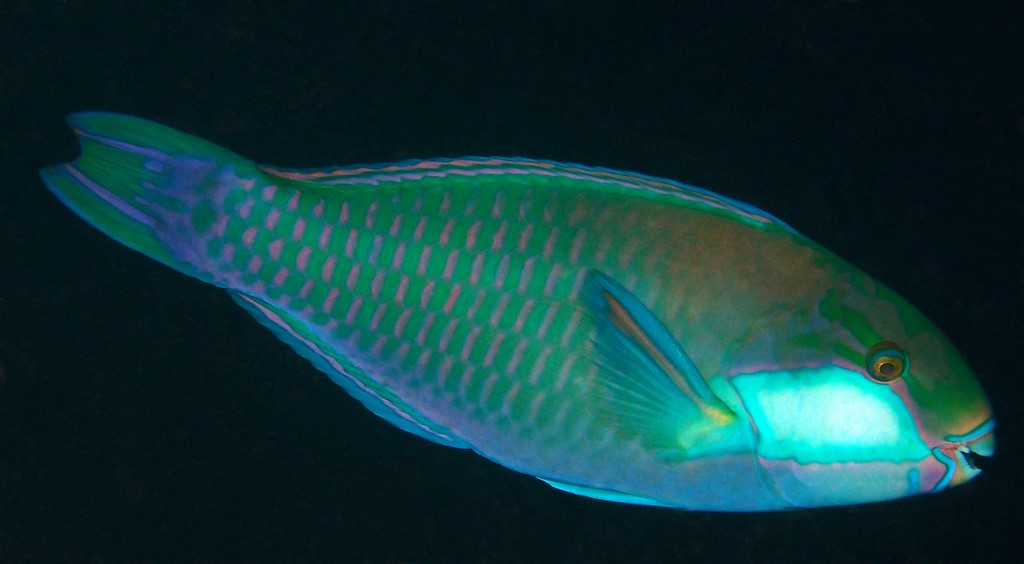CHLORURUS BLEEKERI - (DE BEAUFORT, 1940)
Actinopterygii (Gigaclass) > Actinopteri (Class) > Teleostei (Subclass) > Labriformes (Order) > Labroidei (Suborder) > Labridae (Family) > Chlorurus (Genus)
Perroquet joue blanche, Bleeker's Parrotfish, Okame-budai, オカメブダイ, 白氏鸚嘴魚, 白氏绿鹦嘴鱼,
Synonymes
Callyodon bleekeri (de Beaufort, 1940)
Scarus bleekeri (de Beaufort, 1940)
Scarus cyanotaenia (Bleeker, 1854)
Xenodon cyanotaenia (Bleeker, 1854)
-----------------------
Description
Dorsal spines (total): 9; Dorsal soft rays (total): 10; Anal spines: 3; Anal soft rays: 9; Pectoral fin rays: 15; Medial predorsal scales: 4; Scale rows on cheek: 2, both with 6-8 scales; Scales large. Caudal fin truncate in both color phases. Lips do not cover dental plates. Adults with 1-2 canines posteriorly on side of upper dental plate. Max. length: 49.0 cm TL. Depth range: 3 - 35 m.
Color
Etymology
Chlorurus: from Greek, chloros = green-yellow + from Greek, oura = tail. Referring to green-violet tail of type species, Chlorurus gibbus (Rüppell, 1829).
Bleekeri: in honor of Dutch medical doctor and ichthyologist Pieter Bleeker (1819-1878), who identified this species as Scarus quoyi in 1853.
Original description: Callyodon bleekeri de Beaufort, 1940 - Type localities: Padang, Sumatra; Ternate; Philippines; New Ireland, Ponape, Solomon Islands, Shortland Islands.
Distribution
Eastern Indian Ocean and western Pacific: Myanmar and Indonesia, east to Micronesia and Fiji, north to Philippines, south to northern Australia and New Caledonia.
Biology
Found in clear coastal and inner reefs; in lagoons and channel reefs. Feed mainly on algae. Females usually in small groups and maybe mixed with other species when feeding. Males solitary nearby. Oviparous, distinct pairing during breeding.
Similar species
Last update: 23, September 2024
Perroquet joue blanche, Bleeker's Parrotfish, Okame-budai, オカメブダイ, 白氏鸚嘴魚, 白氏绿鹦嘴鱼,
Synonymes
Callyodon bleekeri (de Beaufort, 1940)
Scarus bleekeri (de Beaufort, 1940)
Scarus cyanotaenia (Bleeker, 1854)
Xenodon cyanotaenia (Bleeker, 1854)
-----------------------
Description
Dorsal spines (total): 9; Dorsal soft rays (total): 10; Anal spines: 3; Anal soft rays: 9; Pectoral fin rays: 15; Medial predorsal scales: 4; Scale rows on cheek: 2, both with 6-8 scales; Scales large. Caudal fin truncate in both color phases. Lips do not cover dental plates. Adults with 1-2 canines posteriorly on side of upper dental plate. Max. length: 49.0 cm TL. Depth range: 3 - 35 m.
Color
- Initial Phase: body dark brown, edges of scales narrowly orangish, shading to dull orange-red on abdomen and thorax; Body with faint greenish yellow bars, these numbering 3-4 with anterior one predorsal, bars extending only to body mid-line; Posterior caudal peduncle and base of caudal fin greenish yellow, in small Initial Phase individuals caudal peduncle pale yellow to white, fading to orangish brown on death (also fading, a yellowish wash on upper half of head); Upper lip with narrow margin of salmon pink and submarginal band of dull blue-green; Lower lip and chin salmon pink with three transverse dull blue-green bands that join to median dull blue-green band ventrally; Fins orangish to reddish brown, dorsal and anal with faint median longitudinal dark band and narrow dark margin; Pectoral membranes pale; Pelvics with dark lateral margin; Dental plates white; Eye orange-yellow. Viewed underwater, Initial Phase individuals characteristically show irregular lighter bars against dark body coloration, the bars fading rapidly on death.
- Terminal Phase: scales of body green with vertically elongate rosy salmon bar, except abdomen and thorax green, and anterodorsally body and nape yellowish; Large whitish area on cheek bordered by blue-green; Lips faintly salmon, band of this color continuing from rictus to lower edge of eye and along upper edge of large pale area on cheek; Transverse turquoise band on upper lip and two on chin; Green band extending anteroventrally and two posterodorsally from eye; Dorsal fin salmon with blue margin, green at base, with median longitudinal green band; Anal fin blue-green basally, turquoise distally, the two regions separated by band of salmon; Caudal fin turquoise with salmon band in each lobe and short streaks of this color centrobasally; Pectoral fins largely turquoise with streak of salmon in upper part and whitish at base; Pelvic fins pale salmon with blue lateral margin; Dental plates greenish.
Etymology
Chlorurus: from Greek, chloros = green-yellow + from Greek, oura = tail. Referring to green-violet tail of type species, Chlorurus gibbus (Rüppell, 1829).
Bleekeri: in honor of Dutch medical doctor and ichthyologist Pieter Bleeker (1819-1878), who identified this species as Scarus quoyi in 1853.
Original description: Callyodon bleekeri de Beaufort, 1940 - Type localities: Padang, Sumatra; Ternate; Philippines; New Ireland, Ponape, Solomon Islands, Shortland Islands.
Distribution
Eastern Indian Ocean and western Pacific: Myanmar and Indonesia, east to Micronesia and Fiji, north to Philippines, south to northern Australia and New Caledonia.
Biology
Found in clear coastal and inner reefs; in lagoons and channel reefs. Feed mainly on algae. Females usually in small groups and maybe mixed with other species when feeding. Males solitary nearby. Oviparous, distinct pairing during breeding.
Similar species
- Chlorurus troschelii (Bleeker, 1853) - Reported from eastern Indian Ocean and western Pacific: Andaman Islands, Myanmar, western Thailand and western Indonesia.
- Chlorurus sordidus (Forsskål, 1775) - Reported from Red Sea and Indian Ocean: Eastern Cape and KwaZulu-Natal (South Africa), East Africa, Persian Gulf, Socotra (Yemen), Seychelles, Aldabra (Seychelles), Comoros, Madagascar and Mascarenes (La Réunion, Mauritius, Rodrigues), east to Bali (Indonesia). Very small initial phase individuals may be confused with small Chlorurus bleekeri.
- Chlorurus spilurus (Valenciennes, 1840) - Reported from New Caledonia - Link to the species (here). Very small initial phase individuals may be confused with small Chlorurus bleekeri.
Last update: 23, September 2024
